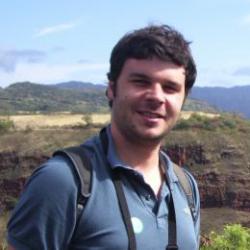Staff
Blain, Hugues-Alexandre
Researcher
Phone: (+34) 607 982 199
E-mail: hablain@iphes.cat
Web: https://sites.google.com/site/huguesalexandreblain/home
Sponsor: IPHES-CERCA
I have earned my PhD (2005) at the Muséum national d’Histoire naturelle (Paris) from a background in Geology and Biology (University of Basse-Normandie, France). As a specialist in fossil amphibians and reptiles, my research applies on a taxonomic approach as my main primary-data paleoecological proxy to reconstruct the climate and landscapes of the Early Pleistocene (2.6 to 0.8 Ma), in relation with human paleoecology. For that, I have adapted and developed a strong methodology, combining other proxies, to infer quantitative paleoclimate parameters. I am mainly engaged in the study of the amphibians and reptiles from the Iberian Plio-Pleistocene (Orce Archaeological Area, Sierra de Atapuerca, Camp dels Ninots, Almenara-Casablanca, Quibas, Pinilla del Valle, among others), but also abroad in France, Italy, Belgium, UK, Poland, Serbia, Georgia, Armenia, Israel, Morocco, Tanzania, etc.
Up to date, I have 160 published papers in SCI first ranked journals, 40 as first author, with an h-index 35 (Scopus). I am currently leading a project from the Spanish Ministry of Science and Innovation (PID2021-122533NB-I00), and lead 8 funded projects: one Leakey project (2022-2023), one from the Spanish Ministry of Economy and Competitiveness (CGL2011-13293-E/BTE), and got several Synthesys-EU grants (in Berlin, Brussels, and London). I am also currently coordinator of the Paleoecology Research in the Orce Archaeological Project (2018-2021 and 2022-2026), funded by the Government of Andalusia.
With this track, I am currently testing and unifying the different methodologies based on small vertebrates, sharpening paleoclimate estimates based on continental records, in order to contrast climate changes on land, biodiversity loss and hominin dispersal models.
My international visibility led me to act as Guest Editor in three special issues (2022 in Archaeol. Anthropol. Sci., 2020 in Quat. Sci. Rev. and in 2016 C.R. Palevol) from symposia in which I was an organizing member (“Quaternary small vertebrates: state of the art and new insights” XVI EAVP, Lisbon, 2018), (“Biochronology, biostratigraphy, and paleoecology of the Quaternary of Europe” UISPP 2014, Burgos), (3rd MicroVertebrate Working Group meeting, Tarragona, 2020).
Regarding academic issues, I am teaching Human Paleoecology in the European Master in Quaternary and Prehistory, at the Universitat Rovira i Virgili. Up to the date, I supervised three PhDs (URV, 2020, 2021, 2023), and I am co-supervising two granted ones (one at URV and one at the Hebrew Univ. of Jerusalem). I have also co-supervised a bachelor thesis (2015, UAH), 3 Master theses (2014, University of Milan; 2016, UAH; 2018, URV). I have been part of 14 PhD juries, at URV (3 theses); UNIZAR (2 theses); UAB; UV; Univ. of Torino (Italy, 2 theses); Univ. of Patras (Greece); Hebrew Univ. of Jerusalem (Israel); Univ. of Carthage (Tunisia); Univ. of Witwatersrand (South Africa), and Univ. of Haifa (Israel). Moreover, since 2009 I reviewed a total of 110 manuscripts for SCI journals, and I took part as project evaluator for the Netherlands Organisation for Scientific Research (The Netherlands), Fédération Nationale de la Recherche Scientifique (Belgium), Agence Nationale de la Recherche (France), and the Swiss National Science Foundation (Switzerland).
My current research project funded by the Spanish Ministry of Science and Innovation (PID2021-122533NB-I00) “Using climate envelope models to predict spatial and temporal distribution patterns of climate-related Quaternary extinctions”, in co-supervision with Juan Manuel López-García (IPHES), and gathering 21 researchers from different universities, is designed to study the paleobiogeographical patterns and reconstruct potential distribution maps over the Pliocene and Quaternary for extinct groups that were successful and once widely distributed in Europe and that have had to face the increasingly extreme and changing conditions of the Quaternary. This project is designed to answer relevant questions based on a comparative approach combining the reconstruction of climate envelope models and potential paleodistribution maps for a selection of rodents, bats, birds, reptiles, amphibians, mollusks, and tree taxa.



